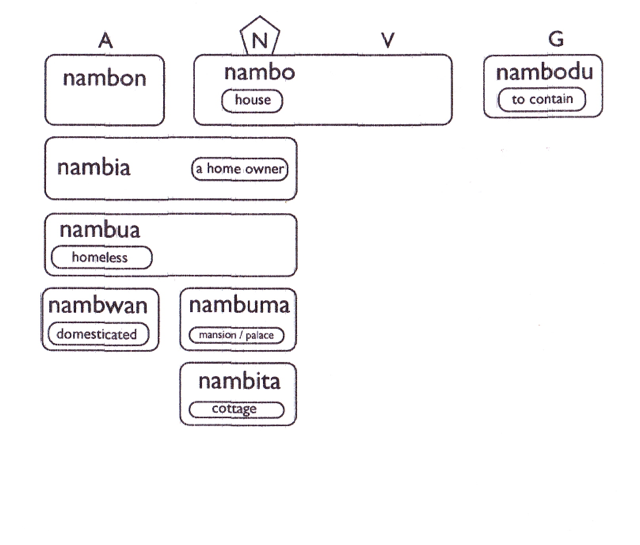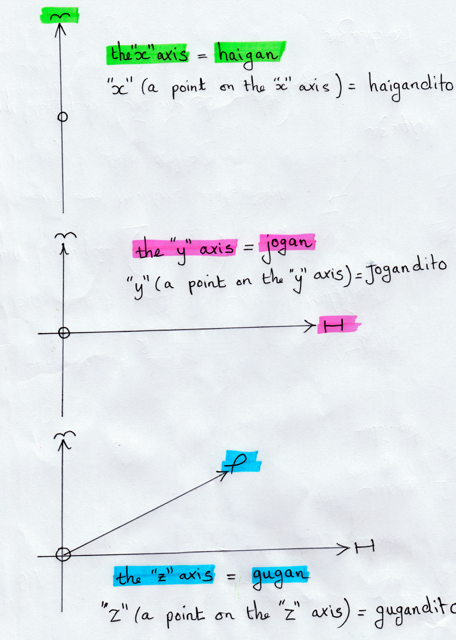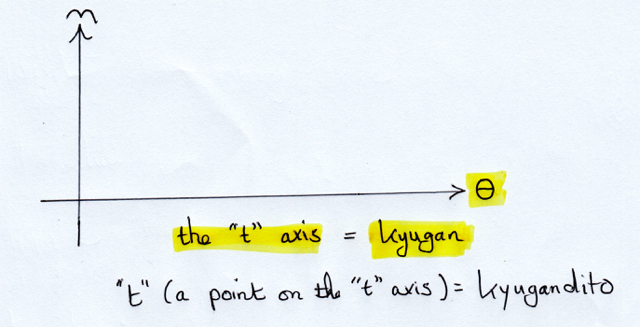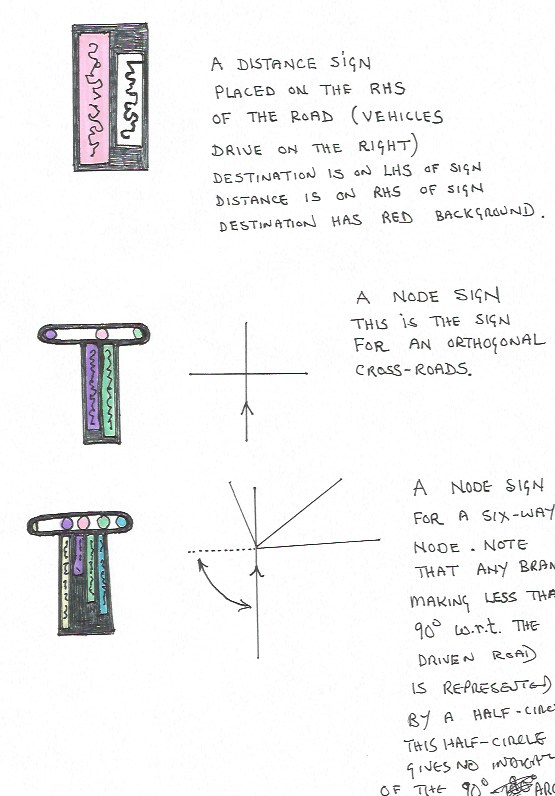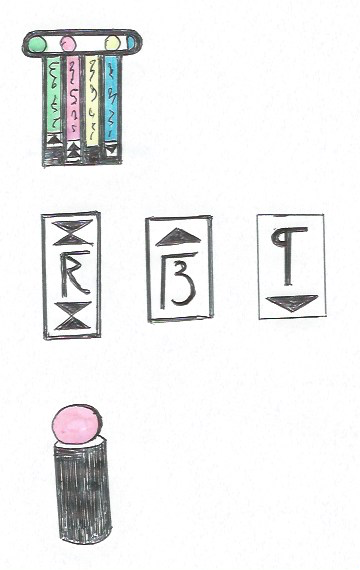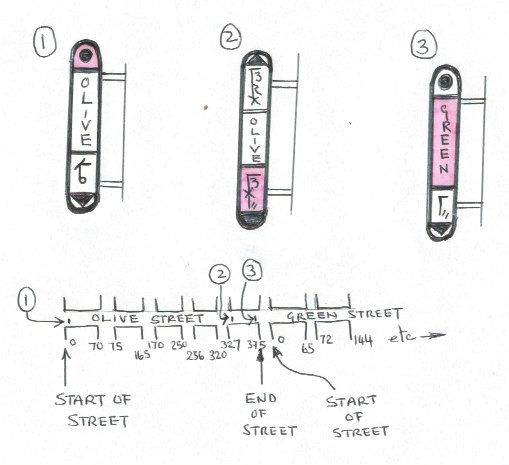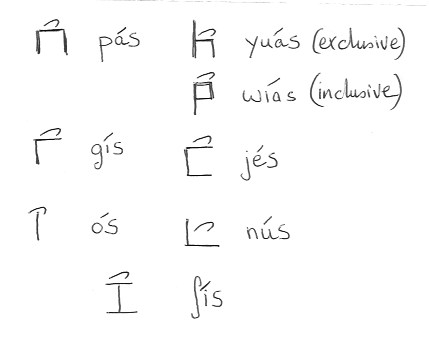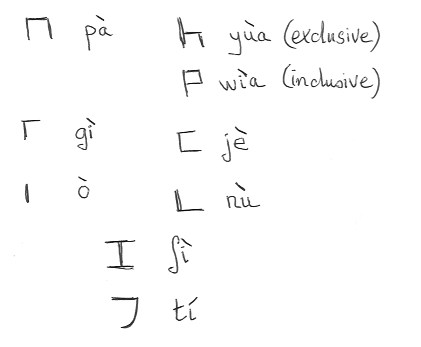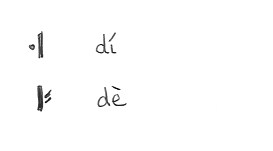Béu : Chapter 8: Difference between revisions
| Line 656: | Line 656: | ||
Note '''moloi''' = slant, slop, incline, gradient .... '''fenda''' = area | Note '''moloi''' = slant, slop, incline, gradient .... '''fenda''' = area | ||
.. | |||
== ..... Signage== | |||
=== ... Road=== | |||
.. | |||
[[Image:TW 232.png]] | |||
[[Image:TW_233.png]] | |||
[[Image:TW_240.png]] | |||
The above is what you pass through when you enter a town. There can be no "Welcome to Pleasantsville" written. It should just be a plane red colour on top. The name of the town on the sides. | |||
On the opposite side of this sign, the red colour will be green. There will be nothing at all written anywhere on the other side ... next town ??? | |||
.. | |||
=== ... Major Buildings=== | |||
.. | |||
Quite similar to the node sign for roads is the sign giving directions in major buildings (such as airports, train stations etc.). However the position of the coloured circles does not show the angle that the joining road takes at the intersection. It shows the angle from the reader to the destination beacon. Actually there is a big black ring on the floor and it is assumed that the reader is within this ring. It is the angle from this ring to the destination beacon that is represented by the position of the coloured circles. | |||
At the bottom of the below diagram, can be seen the destination beacon. It is a sphere about 50 cm in diameter. It is supported by a black pillar which is about 6 foot high. The beacon colour follows the colour of the circle in the sign. The beacon should be located in a clear (unobstructed) area maybe about 20 or 30 mtrs from the destination (for example toilets, information desk, screens displaying timetables, passport control etc. etc.). For course the destination should be clearly visible from near the beacon. | |||
[[Image:TW_241.png]] | |||
The signs at the middle of the above diagram are found near stairways and escalators. Upon stepping off a stairway the sign on the LHS should be clearly visible. This shows what floor you are on (ground floor is floor one by the way). The other two signs are positioned near the entrance to a stairway and tell you where the stairway is going. | |||
.. | |||
=== ... Streets=== | |||
.. | |||
[[Image:TW_244.png]] | |||
Above can be seen a street sign. These street signs are placed in from the corner, a distance equal to half the width of the street (measured building wall to building wall). They are well above head hight and offset from the wall by 60 % of their width. In the middle section is written the name of the street. | |||
In the top section there is the distance along the street of the nearest corner. In the bottom section is the distance along the street of the next corner (measured in units of 2.13 mtrs ... houses do not have numbers as such ... they are all addressed as to how many mtrs they are along the street). Now the sign shown is what you see looking from the corner towards the street. What is written on the back side of the sign is exactly the same as you would see if you looked over directly behind you and saw the sign across the street (i.e. at an intersection you will see eight signs, but they come in pairs that are exactly the same). | |||
One side of the street will have negative numbers. If you are walking away from the centre of town, then the negative numbered side will be on your left. If you are walking around the centre in an anti-clockwise direction, then the negative numbers will be on your left. | |||
The start of the street is marked will the symbol for zero (a black dot), and no black triangle. | |||
The end of the street is marked by that part of the sign having a red background (and no triangle). | |||
[[Image:TW_245.png]] | |||
To try and give you an idea of the system, I have drawn the diagram above. The signs 1, 2 and 3 are what you see on "olive street" at positions 1, 2 and 3. | |||
What I have shown as pink should actually be red. I have done a bad drawing. Every instance of "olive" should be the exact same size. A lot of the signs will be different heights as no blank spaces are allowed inside a sign. Only one font and font size are allowed for every sign in a town. | |||
One further point. If you are walking from the centre of town, and the street you are on is within 18 degrees of directly out from the centre, then every street name you see will have a green background (However the red background has precedence when green and red both apply). | |||
No street can be longer than 1,872 units long (about 4 km) | |||
.. | |||
== ..... Symbols == | |||
.. | |||
Words are not always written out in full. Certain common words have their own special symbol. For instance the ergative pronouns ... | |||
[[Image:TW_234.png]] | |||
And the non-ergative pronouns ... | |||
[[Image:TW_235.png]] | |||
The words "table" = '''pazba''', "bracket" = '''gizgi''', "interior wall" = '''ozdo''' and "chair" = '''yuzlu''' have probably got some relationship with the above symbols. | |||
And the determiners ... | |||
[[Image:TW_236.png]] | |||
Note that '''dè''' looks similar to the sign for '''dùa''' ... similar but not exactly the same. The two slanting strokes meet the vertical stroke exactly halfway along for '''dè'''. | |||
And the particles '''lè''' "and" and '''lú''' "or" ... | |||
[[Image:TW_243.png]] | |||
.. | |||
== ..... Some Musings== | |||
.. | |||
<sup>*</sup> WHAT ??? ... To get enough food ... is that it ?? | |||
it is not a complete answer ... but it is about 80% or 90% of the answer) | |||
E) ... Other bits and pieces ... but really, they pale into insignificance compared to D). | |||
----- | |||
However that fact should not condemn it to disregard. By arranging the '''beukia''' in such a way that people of "compassion" and "taste" always rise to the top of the organisation and and also by having a method that allows for continuous revision of every aspect of itself, '''béu''' should produce truths and ways that are very worthy of regard. | |||
------- | |||
"béu" specifies certain "best practices" for many many aspects of life. These "best practices" encompass many varied aspects of life. | |||
For example the manner in which the 5 yearly festivals should be celebrated, what screw shapes and sizes should be used, how a man should treat his wife and a woman her husband, the periods of fasting and dietary restrictions that each individual should undertake. | |||
These are just some examples of these "best practices". Actually each of these "best practices" are given a level of importance. There are 3 of these levels ... "recommended", "highly recommended" and "an absolute must". | |||
These "best practices" are set out in various books. Theses books are held to be "canonical" or holy. However these writings are not set in stone, and there are mechanisms where by these books are updated and also new books can be added to the "special books". | |||
Some people consider these "special books" to constitute a religion that has no god. However other people follow these "best practices" as just "cool things to do" and fit them in to their lives under another over-reaching belief system, such as Christianity or Islam (in much the same way that the early Buddhist adherent were free either to forget the old hindu gods or to continue to venerate them). | |||
------- | |||
'''béu''' place great importance upon education and lifelong learning. There is a core body of work that all '''béume''' must read. Also there are a great many “recommended works” that they are encouraged to study. | |||
The most important “daily ritual” is 15 minutes given over to the study of these books.. | |||
'''béume''' are expected to show generosity, hospitality, and to constantly pursue of social justice and reform of poor institutions. They are discouraged from the excessive pursuit of luxury and status. | |||
Rather … they believe that in order to be happy, you need … | |||
1) A community of good friends | |||
2) To be engaged in work that gives satisfaction (as part of this self-empoyment is look favourably on) | |||
3) To spend a part of each day in contemplation (reading the holy books is believed engenders this contemplation) ... '''beume''' believe that the highest calling in life is to expand the body of knowledge that humanity possesses ( '''peugəŋgau''') ... to accomplish addition or amendment to one of the treasure of books that are considered "cannonical" is to gain the greatest regard possible from fellow '''beume'''. | |||
For the harmonious functioning of society as a whole, everybody should follow the rule … | |||
1) What you do not wish for yourself, do not do to others | |||
------ | |||
Probably the most detailed part of '''béu''' is '''beuba''' (the language of '''béu'''). | |||
First some new words concerning '''béu''' ... | |||
'''beuki''' = a person that follows '''béu''' and takes part in the community of '''béu''' | |||
'''beume''' = a person that follows '''béu''' but follows in a private manner.<sup>*</sup> | |||
'''beugan''' = all the people that follow '''béu''' plus all the paraphernalia of '''béu''' (i.e. buildings, flags, clothes, etc. etc.) | |||
Note ... I will not use the term '''beuba''' from now on ... I shall simply say '''béu'''. This is sufficient since it is obvious that I am talking about the language. In a similar way, in a book about language you do not continuously come across the term "the English language" ... but rather "English". | |||
------ | |||
The foundations of '''béu''' | |||
Some questions and answers ... | |||
Question ... What is '''béu''' ? | |||
Answer ... '''béu''' is a way of life. | |||
Question ... Where does '''béu''' come from ? | |||
Answer ... Well '''béu''' was wilfully constructed here, down on earth, by humans. But actually '''béu''' is designed to evolve over time, so maybe it is better to say that '''béu''' is "being constructed", rather than "was constructed". | |||
Question ... Why was '''béu''' constructed ? | |||
Answer ... '''béu''' was constructed to fill a gap in the life of a man. Or perhaps it would be better to say ... '''béu''' was constructed to fill a gap in the lives of men. | |||
Question ... What was the starting point in this construction ? | |||
Answer ... The starting point for constructing '''béu''' was to ask two questions. Which were .... | |||
----- | |||
What is a human being ? | |||
What is the point of life ? | |||
After some thought the first question was answered on three different levels … | |||
A) ... A collection of genes. | |||
B) ... A collection of urges ... to eat, to drink, to have sex, etc etc etc | |||
C) ... A network of friends and family … loved-ones. | |||
And after some further thought the answer to the second question was answered … | |||
D) … To get enough food.<sup>*</sup> | |||
----- | |||
'''béu''' is an attempt to build a "framework" for life. A framework that is compatible with the 4 answers given above. But why a framework, you might ask. Well it seems to be a psychological need. Because people are happier when they are told what they can and can not do, what goals are worth striving for and which are worthless. And also as part of this "framework" ... well people like "ritual", they like purposeful action without too much thought, they like the thought that they are part of something bigger than themselves, they like to feel meaning in their lives, they like to feel that they are part of a tradition that stretches back eons and eons. ( OK ... '''béu''' can not fulfil the last item ... or at least, not at the moment) | |||
In short '''béu''' is a gigantic collection of meme's ... aesthetically pleasing and slotting together harmoniously with each other. | |||
.. | |||
Three basic concepts ... '''angwa''', '''honda''' and '''aska''' | |||
At the centre of this body of work defining the "best practices" there are 3 important concepts. | |||
'''angwa''' can best be translated as "harmony" | |||
When used in relation to motion it can be translated as "grace" | |||
When used in relation to design it can be translated as "elegance" | |||
When used in relation to text it can be translated as "poetry" | |||
'''angwai''' is an adjective meaning "graceful", "elegant" or "poetic" | |||
'''angwa''' is considered getting the right balance between '''honda''' and '''aska''' | |||
'''honda''' can best be translated as "order" | |||
'''aska''' can best be translated as "chaos" | |||
.. | .. | ||
Revision as of 21:45, 17 December 2015
..... Nouns and how they pervade other parts of speech
nambo
nambo meaning house is a fairly typical non-single-syllable noun and we can use it to demonstrate how béu generates other words from nouns.
nambodu
Not many nouns can be used as verbs. However when an action is associated to a certain noun, usually, with no change of form, it can be used as a verb. For example lotova means bicycle and you get lotovarwi meaning "I used to ride my bicycle". For the infinitive, du must be affixed to the basic form.
The meaning given to the verb nambo is arrived at through metaphor, it is not so straight forward as the bicycle example.
The use of all tools can be expressed in a similar manner to lotova.
nambon
Sometimes in English a bare noun can be used to qualify another noun (i.e. it can act as an adjective). For example in the phrase "history teacher", "history" has the roll usually performed by an adjective ... for example, "the sadistic teacher". This can never happen in béu, the noun must undergo some sort of change. The most common change for nambo is it to change into its genitive form nambon as in pintu nambon "the door of the house". Other changes that can occur are the affixation of -go or -ka. These are used with certain nouns more than others. They are not used that much with the noun nambo so I haven't included them in the chart above. You could use the forms nambogo or namboka if you wanted tho' (they would mean "house-like"). Maybe you would use one of these terms in a joke ... it would stike the listener as slightly odd however.
nambia
This is a very common derivation. Nearly all nouns can take this transformation.
nambia is an adjective meaning "having a home". And its use as a noun is quite common as well, in which case it would probably be translater as "a home owner"
nambua
Also a very common derivation. The opposite of nambia.
nambua means homeless or the homeless
Note that although ia and ua are exact opposites, the usage of the words produced from these affixes do not completely mirror each other. It all depends oner what the base word is.
For example, in this case, the form nambia is a bit rarer than nambia. Also nambua is used more often as an adjective than as a noun, while nambia is used more often as a noun than an adjective.
nambuma
Many of the worlds languages have a suffix that has this roll. Called an "augmentative" in the Western linguistic tradition. Does not really come into play in English but quite common in béu. As well as some basic forms that appear regularly in their augmentative version, any noun can receive this affix. But of course it will stick out if it is not commonly used.
nambita
The opposite of nambuma. Called an "diminutive" in the Western linguistic tradition. In béu it is often used to show that the speaker feels affection for the noun so transformed. There is no trace of the opposite for the augmentative : nobody would use the augmentative to show repulsion.
nambwan
The form changes that produce nambia, nambua, nambuma, nambita, *nambija are *nambeba affected by deleting the final vowel (or diphthong) and then adding the relevant affix. However with this change of form this is not always possible to delete the final vowel (example). In this example it is possible. In fact it is possible if the final consonant of the base word is j, b, g, d,c, s, k, t, l or m.
By the way nambwan means domestic or domesticated. Nearly always when you come across the word it is referring to animals.
Other derivations that are not possible with nambo
I have already mentioned nambogo and namboka which while possible, are not at all common. Also I will mention three other derivations that are quite common however can not occur with nambo.
1) -ija is affixed to the names of animals and give a word meaning the young of that animal. For example;-
huvu = sheep
huvija = lamb
mèu = cat
meuja = kitten
2) -eba is an affix that produces a word meaning "a set of something" where the base word is considered as a central/typical member of that set. For example;-
baiʔo = spoon
baiʔeba = cutlery
= chair
= furniture
nambeba could represent a set comprising (houses, huts, skyscrapers, apartment buildings, government buildings etc etc.), however this is already covered by bundo (derived from the verb bunda "to build").
báu
..... -uʒi and -go
Note that wan tends to be affixed to nouns while uzhi gets affixed to verbs.
| to play | lento | playful | lentuʒi |
| to rest/relax | loŋge | lazy | loŋguʒi |
| to lie | selne | untruthful by disposition | selnuʒi |
| to work | kodai | diligent | koduʒi |
If the verb is monosyllabic, then -go is used instead of -uʒi.
Sometimes it is hard to tell if a word is basically a verb or a noun.
For example eskua is the gomia of a verb which means "to be angry". However it is also a noun meaning "anger".
However we can say that it is basically a verb as eskuʒi "bad tempered" !!!
How do we say "angry" ???
..... Number of categories
So now we can say, béu has ...
1 wepua
2 mazeba .......................... and 2 demonstratives
3 plova ......... participles ........ ʔinʔanandau or whatever words
4 teŋko ........ evidentials ........ relativizers or ʔasemo-marker
5 seŋgeba ..... modals ..... and 5 specifyana
6 ʔanandau ... question words
7 cenʔo ......... subject marked on the verb
9 ??? .............. personal pronouns
12 pilana (noun cases),
15 "specified"
16 gwoma (tense/aspect verbal affixes).
best to have 10 ??? conjunctions ???
The complement clause construction ???
wí = to see polo = Paul timpa = to hit jene = Jenny
wori polo timpa andai = He saw paul hitting something
wori pá timpana ó = He saw me hitting her
wori jene bwò timpa = He saw Jenny being hit
wori polo timpa jene = He saw Paul hitting Jenny
wori pà timpa jene = He saw me hitting Jenny.
In the above constructions the word order must be as shown above.
..... Want
Maybe I should forget about the subjunctive (ends in xn, before ended in xs, maybe should end in xk) and do things another way ??
If then the
1) wár bái nambo => I want to go home ............. bái is infinitive ............ bái and nambo can not be separated
2) wár bís nambo => I want you to go home ... bís is subjunctive ........ bís and nambo can not be separated
3) wár timpis ò => I want you to hit her/him ... timpis is subjunctive ... timpis and ò can not be separated
I wish that you had hit her/him => wár tà (gìs) timpir ò ???
I wish that you would hit him => ???
So in the above ... the construction as in 1) is used when the person doing the wanting, is also the subject (A or O) of the action required and the second action sort of "follows on" from the "wanting".
The construction as in 2) and 3) is used when the person doing the wanting is different from the subject (A or O) of the action required. The second action again sort of "following on" from the "wanting".
The construction as in 4) is used when the person doing the wanting is different from the subject (A or O) of the action required AND the second action DOES NOT "following on" from the "wanting".
TO THINK ABOUT
Now we have said before that béu has free word order, however this really only applies to the verb in R-form (R) and the S argument in an intransitive clause, and the R, A and O in a transitive clause. When you have a verb in gomia-form (G), in the subjunctive form (Sub) or in the imperative form (Imp), you must have these elements in the following order ;-
S G : S Sub ... the last of these (S -S ) is quite unusual. Maybe can have S I ... but then S must be in vocative case
A G O : A Sub O : Imp O ... expand this and make it look good. Maybe can have A I O ... but then A must be in vocative case
In the béu linguistic tradition, a clause that has one R verb in it, or one N verb, or one I verb is called aʒiŋko baga or a simple clause. Any clause that has an R verb plus an G or N, verb is called a aʒiŋko kaza or a complex clause.
..... Start, Stop, Try
In béu, three secondary verbs (in English) are expressed by a copula plus a pilana. They are ...
to start drinking => láu solbelke
to stop drinking => láu solbelfe
to try drinking => sàu solbewo
And just to demonstrate that the above doesn't necessary lead to confusion ...
He talks about drinking => cator solbewo
We talk about trying to drink => catair wo sàu solbewo
So in fact the gomia take 8 of the 12 pilana ... ji ge n ho la lfe lkx wo
The ergative s also occurs but only in its prepositional form sá
..... -am- as a none-productive infix
klói = to see
klamoi = to show
tàu = to know
tamau = to tell
bái = to go, to move
bamai = to drive
kàu = to come
kamau = to summon
fyu = to fly
fyamu = to throw
gwoi = to jump (involuntarily), to give a start
gwamoi = to make somebody jump, to give somebody a start
doika = walk
damoika = to manage, to run ......... damoikanai = "the management" or "the managers"
..... To think about
Further uses of the "s" form of the verb. That is the subjunctive.
Also used in dependent clauses with the meaning ...
that xxx should yyy.
Used after "want/hope/believe ?" if the subject is different. If subject is the same then the verb is in the gomia form.
hear, see, think, like, remember, know, believe | use tà + full verb with FACT complements.
hear, see, like, remember | use gomia with ACTION complements (English would use "-ing")
Sometimes when English would use the "to" construction, béu would use the -u participle | remember
Some rubbish
poma = leg
pomas = to kick, pomari = I kicked
pomaswan = liable to kick, fond of kicking
pomonda = good to kick
klonda = worth seeing
To fix up this bit.....Of course we can make two clauses, and have the second clause one element inside the first clause. To do that you must use the particle tà. Equivalent to one of the uses of "that" in English. tà basically tells you that the following clause should be treated like a single element, like a single noun.
I should mention sá tà ...
solbe = to drink
heŋgo = to live (or it could mean "a life")
soŋkau = to die (or it could mean "death")
glabu = person
moze = water
moʒi = steam
heŋgola = alive, living
soŋki = dead
..... Examples of prepositions
move these somewhere else
ilai = between
geka = without
mú = outside of
muka = outside
pika = inside
pòi = to enter or to put in
poi.a nambo = go into the house
wi.a toilia di toilicoipi = put these book in the bookcase ... wi.a toilia di toilicoin ... yeah, I like the second version
toilia di TAKE.ia poi.a nambo = take these book into the house
toilia di TAKE.ia nambo.pia jene.kye.a = take these book into the house and give to Jane
TAKE.iya toilia di nambo pireu jene kyireu = take these book into the house and give to Jane
méu = to exit or to take out ... I guess cat must be mèu
miwa nambo báin = come out of the house, get out of the house
.... -GO
| pronounced | operation | label | example |
| -go | noun => adjective, plus adjective => adjective, plus verb => adjective | "ish" | gla.go = effeminate, hia.go = reddish, bla.go = quarrelsome |
-go
gó = to resemble, to be like
gó dó = to be the exact image of
gla.go = effeminate, hia.go = reddish, bla.go = quarrelsome
Sometimes the -go derived words have negative connotations, as in gal.go
There is a suffix -ka (notice it is not considered a pilana), that often has a positive connotation, sometimes making a couplet with a -go derived word. For example ;-
gla.ka = womanly
kài = to appear, to seem
kò = appearance
..... Opposite meaning, same word class
The prefix for adjectives is "u"
taitau = many
utaitau = few
mutu = important
umutu = unimportant
The prefix for adverb is "u"
nan = for a long time
unan = not for a long time
The prefix for nouns is "u"
mezna = to fight
meznana = combatant
umeznana = non-combatant
As in English, not found that often. Sometimes found in rule books.
However the prefix for verbs is "ku"
| kunja | to fold | kukunja | to unfold |
| laiba | to cover | kulaiba | to uncover |
| fuŋga | to fasten, to lock | kufuŋga | to unfasten, to unlock |
| benda | to assemble, to put together | kubenda | to take apart, to disassemble |
| pauca | to stop up, to block | kupauca | to unstop |
| sensa | to weave | kusensa | to unravel |
| fiŋka | to put on clothes, to dress | kufiŋka | to undress |
| tasta | to tangle | kutasta | to untangle |
Note ... if they verbal prefix was simply u, then the same word would mean both "non-folding" and "unfolding"
kunja = to fold
kunjana = "folding" (an adjective) or "one that folds" (a noun)
kukunjana = "unfolding" or the "unfolder"
ukunjana = "non-folding" or "one that doesn't fold"
..
... Names of religions
..
klisti = chistianity ... klistime = a christian (but not necessarily a churchgoer ... a believer) ... klistiki = a minister, a priest ... klistida = christendom (archaic term)
muzlu = islam ... muzlume = a muslim
buda = buddhism ... budame = a buddhist
yuda = judism ... yudame = a jew ... yudaki = a rabbi
sai.entolo = scientology ... sai.entolome = a scientologist
Note .... None of the above take the gan suffix in the manner béu does.
Note ... The ideas conveyed by béu and béugan overlap to a great extent. Maybe beugan is first used when first introducing the concept into a conversation, but after that just béu is considered sufficient. Also as a noun qualifier, béu is the form normally used.
Note ... béu can takes the place in a persons life normally taken by a religion, however following the way of béu does not bar one from following another religion. Just as being a Buddhist doesn't necessary force one to reject the Hindu gods.
Note ... béu is one of the few words that takes both the ki suffix and the me suffix.. Usually a noun would only be augmented with one of them. For example ...
pulis = the police ... puliski = a policeman (or policewoman) ... ʔazwo = milk ... ʔazwome = a milkman
It is thought that policemen co-ordinate their activities together and hence are given the -ki suffix.
It is thought that the milkmen don't o-ordinate their activities and hence are given the -me suffix.
Of course you might come across a situation where the police fail to co-ordinate their activities and a group of milkmen co-ordinate their activities brilliantly ... nevertheless ... puliski = policemn and ʔazwome = milkman.
Note ... beuda would be a contiguous area under béu political control ... similar to Christendom ... probably will never happen
..
The parish hall
..
Below is shown the plan of the parish hall. This is the administrative centre of the parish and the place where the banner-rows point to.
The parish hall is referred to as kas.heu. This refers to the hexagonal main building and the ancillary buildings and the adjoining grounds. If you want to refer to the main building alone you say elaʔa (the hexagon).
The red shape at the top of the plan is the water-fountain. It must have a red tiled roof. It is to provide clean drinking water to passers by and also a sheltered place to rest. It can take a variety of forms. Some are made very fancy and have a small "hanging garden" along their centre surrounded with pools filled with beautiful fish. There must be fresh water flowing, either continuous or on demand. Also there must be seating. There is also a small banner-row of 3 banners ... in line with the "water-hut" and on the side away from the elaʔa.
There is often a tree lined avenue leading up to the front entrance of the kas.heu. In hot countries the trees are usually some sort of shade tree. In colder countries, trees with a well defined, uniform shape are favoured ... poplars ?? The two rows of trees diverge from each other as the road passes the row of three banners. They open up to encompass the "poster-huts" but don't extend beyond them.
Usually 2 or 3 other types of tree are planted around the elaʔa (maybe 5 or 6 trees in all). This makes every kas.heu unique.
The whole complex provides the following services ...
1) A clocktower
2) Public toilets
3) A post office
4) A library
5) Archives for public records
6) A place for the parish council to meet
7) Offices for the parish council members
The black part of the elaʔa is the main entrance.
You will notice to "huts" with half their roof red and half black. These are the "poster huts". These are sheltered billboards for posting important information. The red side is for official notices (that is for what the parish officers or the central government think should be posted). On the black side the general public can post whatever it wants. New notices are posted on the small "poster hut". After 9 days they are transferred to the larger "poster huts". In béu the adjective "red" can be used to refer to something pertaining to the government, and the adjective "black" to refer to something non-government.
The orange part of the elaʔa is a stage, or actually the roof over the stage. And the area in front of this stage is a fairly large green where people gather to see the various shows that are put on. There are various conserts put on by the parish members at regular times every year. Also occasionally you get wondering groups of "players" who put on a show.
Above is how the kas.heu looks from street level (the "hut" to the left is the "water hut").
The entrance has about 1.3 m of steps to climb. There are three arches at every entrance. The central one being slightly higher than the other two.
(I have probably drawn the building too high in the street level view). Usually tall stain glass windows on 4 sides of the elaʔa. There is always at least 2 storeys within the main part of the building, sometimes more. Also usually there is a separate storey in the roof (the triangular shapes seen on the plan view, are actually windows in the roof to provide light to this storey. These windows look onto the central courtyard.)
The centre of the hexagon has a pleasing garden. In the very centre is the base of the "clock tower".
The 2 kidney shaped building are public toilets. The one on the right for the use of men, the one on the left for the use of women.
Tables and chair for setting out for the various concerts are also kept in these buildings. These toilets are kept meticulously clean. In fact every parishioner must do a certain amount of duty at the toilets every year ... keeping them clean. No fit adult is exempt from this duty.
There is a single banner just outside each of these buildings ... on the opposite side from the stage.
There are similar roof-colouring rules for other government buildings. Namely the schools have are gray-roofed and the hospitals are dark blue-roofed.
Just as every child (person that has not yet mastered the laws) has his "enjoyment day" (i.e. his birthday) so every parish has its enjoyment day. Every parish has a different enjoyment day and people frequently visit neighbouring parishes to experience the neighbouring parishes enjoyment day. In the enjoyment day there is a parade and people from different organisations and neighbourhood enter "troops" into this parade. Everybody in a troop is flamboyantly and colourfully dressed. Also the pull bizarrely decorated wagons. Usually each troop picks a different theme every year so the dresses and the moves they perform reflect this theme. A prize is usually given to what is judged the best troop, but most people do not take that too seriously. They are just out to enjoy themselves.
At night there is tasty and abundant food available from tents that have been put up on the village green. The food is provided free of charge by the parish.
..
..... Arithmetic, Algebra & Calculus
..
nogau = arithmetic
One further point of note ...
If you wanted to express a number represented by digits 2->4 from the LHS of the monster, you would say auvaidaula nàin .... the same way as we have in the Western European tradition. However if you wanted to express a number represented digits 6 ->8 from the RHS of the monster, you would say yanfa elaibau .... not the way we do it. This is like saying "milli 630 volts" instead of "630 microvolts".
-6 is pronounced komo ela ... komo meaning left or negative.
By the way bene means right (as in right-hand-side) or positive.
4i is pronounced uga haspia** ... and what does haspia mean, well it is the name of the little squiggle that touches the number bar, for one thing.
-4i is pronounced komo uga haspia
-1/10 is pronounced komo diapa
i/4 is pronounced duga haspia
*Actually these placeholder symbols are named after 6 living things. This does not lead to confusion tho'. When you are doing arithmetic these concrete meanings are totally bleached.
**This can also be pronounced as bene uga haspia. However usually the bene bit is deemed redundent.
..
Algebra
WHERE DOES THIS ONE GO ??
..
haijogu = arithmetic
In the West we use x y and z to represent variables. In béu we have 3 special symbols to represent these three variables. The names of these symbols are haigan, jogan and gugan
Also in béu there are certain conventions to adhere to. If we are considering one dimension only, it is invariably called haigan and is represented by an up and down the page (see the diagram below).
If we are considering two dimension, then the variable jogan is added at 90 degrees to the haigan line (see the diagram below).
And if we are considering three dimension, then the variable gugan is added at 60 degrees to the haiganline and 30 degrees to the jogan line (see the diagram below)
I need a name for "i" 1/2 and sqrt 1/2 symbols ???
You will notice that instead of using brackets a horizontal line is placed over the elements that must be considered together. Also exponents are simple placed above the number that they qualify.
Note ... haigan is probably derived from the adjective hái. Likewise jogan from the adjective joga and gugan from the adjective guboi
..
.... Calculus
laigau = calculus
yyyy = straight, straight line ... both an adjective and a noun
xxxx = curvy, a curve ............. both an adjective and a noun
Now xxxx also means function. Or at least instead of talking about putting x into a function (process) and obtaining y, the tradition in béu is to talk about xxxx defined in terms of x and y (either through an equation or simply a list of x and y values)
xxxx is usually written using the sign below.
xxxx is declared to exits in the dimensions (variabes) haigan and kyugan below.
xxxx is defined in terms of an equation below.
Now the differential of xxxx is called molgan xxxxwo and is written as .... (the image on the RHS is the second differential)
And the integral of xxxx is called fendagan xxxxwo and is written as .... (the image on the RHS is the second integral)
Note moloi = slant, slop, incline, gradient .... fenda = area
..
..... Signage
... Road
..
The above is what you pass through when you enter a town. There can be no "Welcome to Pleasantsville" written. It should just be a plane red colour on top. The name of the town on the sides.
On the opposite side of this sign, the red colour will be green. There will be nothing at all written anywhere on the other side ... next town ???
..
... Major Buildings
..
Quite similar to the node sign for roads is the sign giving directions in major buildings (such as airports, train stations etc.). However the position of the coloured circles does not show the angle that the joining road takes at the intersection. It shows the angle from the reader to the destination beacon. Actually there is a big black ring on the floor and it is assumed that the reader is within this ring. It is the angle from this ring to the destination beacon that is represented by the position of the coloured circles.
At the bottom of the below diagram, can be seen the destination beacon. It is a sphere about 50 cm in diameter. It is supported by a black pillar which is about 6 foot high. The beacon colour follows the colour of the circle in the sign. The beacon should be located in a clear (unobstructed) area maybe about 20 or 30 mtrs from the destination (for example toilets, information desk, screens displaying timetables, passport control etc. etc.). For course the destination should be clearly visible from near the beacon.
The signs at the middle of the above diagram are found near stairways and escalators. Upon stepping off a stairway the sign on the LHS should be clearly visible. This shows what floor you are on (ground floor is floor one by the way). The other two signs are positioned near the entrance to a stairway and tell you where the stairway is going.
..
... Streets
..
Above can be seen a street sign. These street signs are placed in from the corner, a distance equal to half the width of the street (measured building wall to building wall). They are well above head hight and offset from the wall by 60 % of their width. In the middle section is written the name of the street.
In the top section there is the distance along the street of the nearest corner. In the bottom section is the distance along the street of the next corner (measured in units of 2.13 mtrs ... houses do not have numbers as such ... they are all addressed as to how many mtrs they are along the street). Now the sign shown is what you see looking from the corner towards the street. What is written on the back side of the sign is exactly the same as you would see if you looked over directly behind you and saw the sign across the street (i.e. at an intersection you will see eight signs, but they come in pairs that are exactly the same).
One side of the street will have negative numbers. If you are walking away from the centre of town, then the negative numbered side will be on your left. If you are walking around the centre in an anti-clockwise direction, then the negative numbers will be on your left.
The start of the street is marked will the symbol for zero (a black dot), and no black triangle.
The end of the street is marked by that part of the sign having a red background (and no triangle).
To try and give you an idea of the system, I have drawn the diagram above. The signs 1, 2 and 3 are what you see on "olive street" at positions 1, 2 and 3.
What I have shown as pink should actually be red. I have done a bad drawing. Every instance of "olive" should be the exact same size. A lot of the signs will be different heights as no blank spaces are allowed inside a sign. Only one font and font size are allowed for every sign in a town.
One further point. If you are walking from the centre of town, and the street you are on is within 18 degrees of directly out from the centre, then every street name you see will have a green background (However the red background has precedence when green and red both apply).
No street can be longer than 1,872 units long (about 4 km)
..
..... Symbols
..
Words are not always written out in full. Certain common words have their own special symbol. For instance the ergative pronouns ...
And the non-ergative pronouns ...
The words "table" = pazba, "bracket" = gizgi, "interior wall" = ozdo and "chair" = yuzlu have probably got some relationship with the above symbols.
And the determiners ...
Note that dè looks similar to the sign for dùa ... similar but not exactly the same. The two slanting strokes meet the vertical stroke exactly halfway along for dè.
And the particles lè "and" and lú "or" ...
..
..... Some Musings
..
* WHAT ??? ... To get enough food ... is that it ??
it is not a complete answer ... but it is about 80% or 90% of the answer)
E) ... Other bits and pieces ... but really, they pale into insignificance compared to D).
However that fact should not condemn it to disregard. By arranging the beukia in such a way that people of "compassion" and "taste" always rise to the top of the organisation and and also by having a method that allows for continuous revision of every aspect of itself, béu should produce truths and ways that are very worthy of regard.
"béu" specifies certain "best practices" for many many aspects of life. These "best practices" encompass many varied aspects of life.
For example the manner in which the 5 yearly festivals should be celebrated, what screw shapes and sizes should be used, how a man should treat his wife and a woman her husband, the periods of fasting and dietary restrictions that each individual should undertake.
These are just some examples of these "best practices". Actually each of these "best practices" are given a level of importance. There are 3 of these levels ... "recommended", "highly recommended" and "an absolute must".
These "best practices" are set out in various books. Theses books are held to be "canonical" or holy. However these writings are not set in stone, and there are mechanisms where by these books are updated and also new books can be added to the "special books".
Some people consider these "special books" to constitute a religion that has no god. However other people follow these "best practices" as just "cool things to do" and fit them in to their lives under another over-reaching belief system, such as Christianity or Islam (in much the same way that the early Buddhist adherent were free either to forget the old hindu gods or to continue to venerate them).
béu place great importance upon education and lifelong learning. There is a core body of work that all béume must read. Also there are a great many “recommended works” that they are encouraged to study.
The most important “daily ritual” is 15 minutes given over to the study of these books..
béume are expected to show generosity, hospitality, and to constantly pursue of social justice and reform of poor institutions. They are discouraged from the excessive pursuit of luxury and status.
Rather … they believe that in order to be happy, you need …
1) A community of good friends
2) To be engaged in work that gives satisfaction (as part of this self-empoyment is look favourably on)
3) To spend a part of each day in contemplation (reading the holy books is believed engenders this contemplation) ... beume believe that the highest calling in life is to expand the body of knowledge that humanity possesses ( peugəŋgau) ... to accomplish addition or amendment to one of the treasure of books that are considered "cannonical" is to gain the greatest regard possible from fellow beume.
For the harmonious functioning of society as a whole, everybody should follow the rule …
1) What you do not wish for yourself, do not do to others
Probably the most detailed part of béu is beuba (the language of béu).
First some new words concerning béu ...
beuki = a person that follows béu and takes part in the community of béu
beume = a person that follows béu but follows in a private manner.*
beugan = all the people that follow béu plus all the paraphernalia of béu (i.e. buildings, flags, clothes, etc. etc.)
Note ... I will not use the term beuba from now on ... I shall simply say béu. This is sufficient since it is obvious that I am talking about the language. In a similar way, in a book about language you do not continuously come across the term "the English language" ... but rather "English".
The foundations of béu
Some questions and answers ...
Question ... What is béu ?
Answer ... béu is a way of life.
Question ... Where does béu come from ?
Answer ... Well béu was wilfully constructed here, down on earth, by humans. But actually béu is designed to evolve over time, so maybe it is better to say that béu is "being constructed", rather than "was constructed".
Question ... Why was béu constructed ?
Answer ... béu was constructed to fill a gap in the life of a man. Or perhaps it would be better to say ... béu was constructed to fill a gap in the lives of men.
Question ... What was the starting point in this construction ?
Answer ... The starting point for constructing béu was to ask two questions. Which were ....
What is a human being ?
What is the point of life ?
After some thought the first question was answered on three different levels …
A) ... A collection of genes.
B) ... A collection of urges ... to eat, to drink, to have sex, etc etc etc
C) ... A network of friends and family … loved-ones.
And after some further thought the answer to the second question was answered …
D) … To get enough food.*
béu is an attempt to build a "framework" for life. A framework that is compatible with the 4 answers given above. But why a framework, you might ask. Well it seems to be a psychological need. Because people are happier when they are told what they can and can not do, what goals are worth striving for and which are worthless. And also as part of this "framework" ... well people like "ritual", they like purposeful action without too much thought, they like the thought that they are part of something bigger than themselves, they like to feel meaning in their lives, they like to feel that they are part of a tradition that stretches back eons and eons. ( OK ... béu can not fulfil the last item ... or at least, not at the moment)
In short béu is a gigantic collection of meme's ... aesthetically pleasing and slotting together harmoniously with each other.
..
Three basic concepts ... angwa, honda and aska
At the centre of this body of work defining the "best practices" there are 3 important concepts.
angwa can best be translated as "harmony"
When used in relation to motion it can be translated as "grace" When used in relation to design it can be translated as "elegance" When used in relation to text it can be translated as "poetry"
angwai is an adjective meaning "graceful", "elegant" or "poetic"
angwa is considered getting the right balance between honda and aska
honda can best be translated as "order"
aska can best be translated as "chaos"
..
Index
- Introduction to Béu
- Béu : Chapter 1 : The Sounds
- Béu : Chapter 2 : The Noun
- Béu : Chapter 3 : The Verb
- Béu : Chapter 4 : Adjective
- Béu : Chapter 5 : Questions
- Béu : Chapter 6 : Derivations
- Béu : Chapter 7 : Way of Life 1
- Béu : Chapter 8 : Way of life 2
- Béu : Chapter 9 : Word Building
- Béu : Chapter 10 : Gerund Phrase
- Béu : Discarded Stuff
- A statistical explanation for the counter-factual/past-tense conflation in conditional sentences
